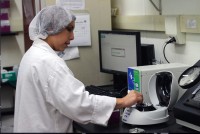This year, more food manufacturing companies than ever are actively seeking software solutions for food safety and quality management. The majority of food businesses still collect food safety records using pen and paper, which is a time-consuming process and is far from reliable. Fortunately, food safety software is drastically changing the way HACCP and other QA/QC data becomes collected and stored. The following are some reasons food safety software is a must-have in 2016.
1. Overwhelming Amount of Paperwork
Many employees at food manufacturing facilities—whether meats, baked goods, or beverages—still rely on pen and paper forms, checklists, and log books to manage their food safety operations. This allows operator errors and omissions to happen far too easily. Even well managed systems that use paperwork can reach a tipping point. Quality managers already have a big enough workload, and piling on the job of verifying all paperwork only increases the chances of a failure.
2. Constant Change in Food Safety Standards
FSMA, the most sweeping reform of food safety laws in more than 70 years, was signed into law in 2011. While most food manufacturers have only been mandated to register, the time of more strict enforcement is coming. Global standards for food safety such as, SQF and BRC, fall within this generation of compliance. The necessities of these programs are constantly changing, becoming stricter and introducing new categories of requirements. Food safety software offers an effective way to deal with the ever-shifting landscape by providing evolving solutions managed by a software provider.
3. Consumer Confidence
Consumer expect a safe and healthy product, and as such, a company must instill a feeling of confidence. When a product is expected to provide nutrition, energy and enjoyment any incidence of foodborne illness will only prevent future confidence in the product. In addition, the consumer is likely to spread the news among peers about how he or she became sick. It is the duty of the food company to do everything in its power to process, store and prepare food in the safest way possible. That process starts with ensuring a higher level of reliability in a food safety program, which can be achieved by using food safety software.
4. Economics
No food company wants to deal with the hassle of a lawsuit from an outbreak or recall. These events can cost thousands, if not millions, of dollars in damages and cause serious loss to a company of any size. Although many companies carry insurance for these occurrences, there still is the loss of sale from consumer mistrust. Investing in software can help companies increase profits by improving efficiencies. For example, companies can measure these efficiencies not only from labor savings but also from significant savings in paper and toner (i.e., saving $2000–$5000 a year).
5. Operator Error and Omission
In an age in which documentation is becoming digitalized, food safety requirements are becoming more tedious. Even the smallest employee error can have massive repercussions. The cost of added staff is one thing, but the reliability of the data and adherence to schedule is another. Relying on inaccurate data collection may result in a recall or damage to a company’s brand.
Pencil whipping (faking paperwork) occurs for a variety of reasons, from employees taking short cuts to avoidance of writing down out-of-spec data. Manual record keeping has proven over time to be prone to errors. Employees, bored with the distraction of measuring and writing down dough or batch temperatures, piece weights or metal detector tests, and fill out forms with moot numbers just to complete the form.
6. Monitoring and Notification
Being aware of control points is another way in which companies can avoid disaster. Food safety software can give companies the ability to monitor oven and freezer temperatures, metal detectors, tests or any other control point in real time. This capability also alerts users when a control point is out of deviation (doing so at a glance), along with sending custom notifications, allowing a plant to quickly address problems while simultaneously properly documenting the issue.
7. Audits: Go from Stressful to Easy
An upcoming audit can be stressful for any company, involving numerous people who are gathering an abundance of documentation. With food safety software there is no reason to scramble to get documentation together or waste precious time preparing it. Auditors can simply view a company’s software for any requested documentation. For example, a company can produce random temperature logs, metal detector times, SSOPs, customer complaints and a variety of other documentation in just a few clicks.
8. The Technology Is Available
One of the reasons why so many companies continue to use paper and Excel-based systems today is because they are unaware of the abilities and functionality available to them. After completing the formidable task of attaining a new-found level of compliance, some companies may find it daunting to continue to go to the next step of converting to a computerized system. Finding user-friendly food safety software that has good customer support, as well as solutions that are customized to user needs, is not necessarily easy. The key is to find software and a supplier that can provide the right solution for your company and food safety program, whether it’s HACCP, BRC or SQF, and ensure that it fits within an acceptable budget. Consider not only the initial cost but also the cost of implementation. What resources will be required? How much can the supplier help with implementation? Having the right answers and the true costs will assist you in arriving at the correct solution.








 PerkinElmer Inc., a global leader focused on improving the health and safety of people and the environment, today announced the launch of its Adulterant Screen™ software. This automated solution can help food industry professionals evaluate the integrity of food ingredients to guard against existing and potential food adulteration threats.
PerkinElmer Inc., a global leader focused on improving the health and safety of people and the environment, today announced the launch of its Adulterant Screen™ software. This automated solution can help food industry professionals evaluate the integrity of food ingredients to guard against existing and potential food adulteration threats.
